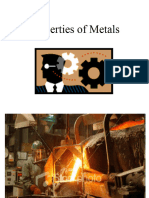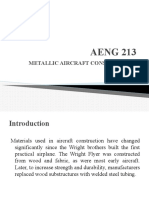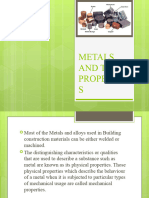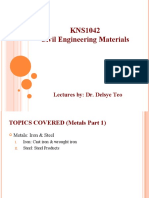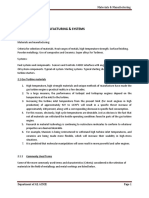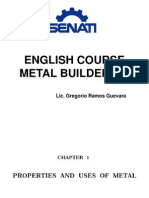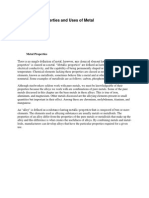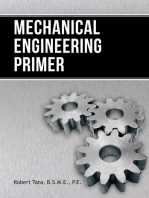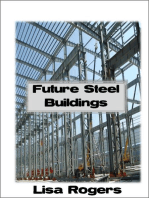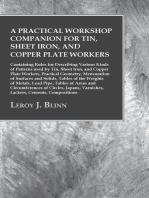0 ratings0% found this document useful (0 votes)
17 viewsMaterials and Methods of Construction
Materials and Methods of Construction
Uploaded by
alexanderThe document discusses materials and methods used in gas turbine engine construction. It describes how increasing the turbine inlet temperature from 1700°F to 2500°F can increase thrust by 130% while decreasing fuel consumption. It also notes that not all materials can withstand the harsh operating conditions inside a gas turbine engine. The document then discusses various metal properties like hardness, brittleness, malleability, ductility, elasticity, toughness, conductivity, fusibility, density, contraction/expansion, strength, and terms used in metallurgy like creep strength, yield strength, rupture strength, ultimate tensile strength, ductility, and thermal shock resistance.
Copyright:
© All Rights Reserved
Available Formats
Download as PDF, TXT or read online from Scribd
Materials and Methods of Construction
Materials and Methods of Construction
Uploaded by
alexander0 ratings0% found this document useful (0 votes)
17 views10 pagesThe document discusses materials and methods used in gas turbine engine construction. It describes how increasing the turbine inlet temperature from 1700°F to 2500°F can increase thrust by 130% while decreasing fuel consumption. It also notes that not all materials can withstand the harsh operating conditions inside a gas turbine engine. The document then discusses various metal properties like hardness, brittleness, malleability, ductility, elasticity, toughness, conductivity, fusibility, density, contraction/expansion, strength, and terms used in metallurgy like creep strength, yield strength, rupture strength, ultimate tensile strength, ductility, and thermal shock resistance.
Original Description:
Original Title
ALUMNO NUMERO 11
Copyright
© © All Rights Reserved
Available Formats
PDF, TXT or read online from Scribd
Share this document
Did you find this document useful?
Is this content inappropriate?
The document discusses materials and methods used in gas turbine engine construction. It describes how increasing the turbine inlet temperature from 1700°F to 2500°F can increase thrust by 130% while decreasing fuel consumption. It also notes that not all materials can withstand the harsh operating conditions inside a gas turbine engine. The document then discusses various metal properties like hardness, brittleness, malleability, ductility, elasticity, toughness, conductivity, fusibility, density, contraction/expansion, strength, and terms used in metallurgy like creep strength, yield strength, rupture strength, ultimate tensile strength, ductility, and thermal shock resistance.
Copyright:
© All Rights Reserved
Available Formats
Download as PDF, TXT or read online from Scribd
Download as pdf or txt
0 ratings0% found this document useful (0 votes)
17 views10 pagesMaterials and Methods of Construction
Materials and Methods of Construction
Uploaded by
alexanderThe document discusses materials and methods used in gas turbine engine construction. It describes how increasing the turbine inlet temperature from 1700°F to 2500°F can increase thrust by 130% while decreasing fuel consumption. It also notes that not all materials can withstand the harsh operating conditions inside a gas turbine engine. The document then discusses various metal properties like hardness, brittleness, malleability, ductility, elasticity, toughness, conductivity, fusibility, density, contraction/expansion, strength, and terms used in metallurgy like creep strength, yield strength, rupture strength, ultimate tensile strength, ductility, and thermal shock resistance.
Copyright:
© All Rights Reserved
Available Formats
Download as PDF, TXT or read online from Scribd
Download as pdf or txt
You are on page 1of 10
MATERIALS AND METHODS OF CONSTRUCTION
High-temperature, high-strength materials and
unique methods of manufacture have made the gas
turbine engine a practical reality in a few decades. The
performance of turbojet and turboprop engines depends
largely on the temperature at the inlet to the turbine.
Increasing the turbine inlet temperature from the present
limit (for most highly produced engines) of approximately
17000F to 25000F will result in a specific thrust increase
of approximately 130 percent along with a corresponding
decrease in specific fuel consumption. For this reason
high cycle temperatures are desirable. Not all materials
can withstand the hostile operating conditions found in
parts of the gas turbine engine.
Properties and Characteristics
Metallurgists have been working for almost 50
years improving metals for use in aircraft construction.
Each type of metal or alloy has certain properties
3-22
and characteristics which make it desirable for a particular
use, but it may have other qualities which are
undesirable. The metallurgist’s job is to build up the
desirable qualities and tone down the undesirable ones.
This is done by the alloying (combining) of metals and by
Various heat-treating processes. It is not necessary for the
airframe repairer to be a metallurgist, but it is advantageous
to have a general knowledge of the properties
used in their development. The repairer should be
familiar with a few metallurgical terms. The following
terms are used in describing the physical properties and
characteristics of metals.
Hardness. Hardness refers to the ability of a
metal to resist abrasion, penetration, cutting action,
or permanent distortion. Hardness may be
increased by working the metal and, in the case
of steel and certain aluminumalloys, by heattreatment
and cold-working. Structural
parts are often formed from metals in their soft
state and are then heat-treated to harden them
so the finished shape is retained. Hardness and
strength are closely associated properties of
metals.
Brittlemem. Brittleness is the property of a
metal which allows little bending or deformation
without shattering. A brittle metal is apt to
break or crack without change of shape. Because
structural metals are often subjected to
shock loads, brittleness is not a desirable
property. Cast iron or cast aluminum and very
hard steel are brittle metals.
Malleability. A metal which can be hammered,
rolled, or pressed into various shapes
without cracking breaking or other detrimental
effects is said to be malleable. This property is
necessary in sheet metal which is worked into
curved shapes such as cowling, and
wingtips. Copper is an example of a malleable
metal.
Ductility. Ductility is the property of a metal
which permits it to be permanently drawn, bent,
or twisted into various shapes without breaking.
This property is essential for metals used in
making wire and tubing. Ductile metals are
preferred for aircraft use because of their ease
of forming and resistance to failure under
shock loads. For this reason, aluminum alloys
are used for cowl rings, fuselage and wing skin,
and formed or extruded parts such as ribs, spars,
and bulkheads. Chrome-molybdenum steel is
also easily formed into desired shapes. Ductility
is similar to malleability.
Elasticity. Elasticity is that property which
enables a metal to return to its original shape
when the force which causes the change of
shape is removed. This property is extremely
valuable, as it would not be desirable to have a
part permanently distorted after an applied load
was removed. Each metal has a point known as
the elastic limit beyond which it cannot be
loaded without causing permanent distortion.
In aircraft construction, members and parts are
so designed that the maximum loads to which
they are subjected will never stress them beyond
their elastic limits. This desirable property is
present in spring steel.
Toughness. A material which possesses
toughness will withstand tearing or shearing and
may be stretched or otherwise deformed
without breaking. Toughness is a desirable
property in aircraft materials.
Conductivity. Conductivity is the property
which nables a metal to carry heat or electricity.
The heat conductivity of a metal is especially
important in welding as it governs the amount
of heat that will be required for proper fusion.
Conductivity of the metal, to a certain extent,
determines the type of jig to be used to control
expansion and contraction. In aircraft,
electrical conductivity must also be considered
in conjunction with bonding to eliminate radio
interference. Metals vary in their capacity to
conduct heat. Copper, for instance, has a relatively
high rate of heat conductivity and is a good
electrical conductor.
Fusibility. Fusibility is the ability of a metal to
become liquid by the application of heat. Metals
are fused in welding. Steels fuse at approximately
2500oF (1371oC), and aluminum alloys fuse at
approximately 1100oF (593oC).
Density. Density is the weight of a unit volume
of a material. In aircraft work, the actual weight
of a material per cubic inch is preferred, as this
figure can be used in determining the weight of
apart before actual manufacture. Density is an
important consideration when choosing a
material to be used in the design of a part in
order to maintain the proper weight and
balance of the aircraft.
3-23
Contraction and expansion. contraction and
expansion are reactions produced in metals as
the result of heating or cooling. A high degree
of heat applied to a metal will cause it to expand
or become larger. Cooling hot metal will shrink
or contract it. Contraction and expansion affect
the design of welding jigs, castings, and
tolerances necessary for hot rolled material.
Strength. Strength refers to the ability of a
metal to hold loads (or forces) without breaking
Strength is a property that sums up many of the
desirable qualities of metals. Strength with
toughness is the most important combination of
properties a metal can possess. Metals
having this combination of properties are used
in vital structural members that may become
overloaded in service.
In a discussion of metal properties, stress and strain
should be mentioned. Stress is a force placed upon a
body and is measured in terms of force per unit area, the
force being expressed in pounds and the unit of area in
square inchs; in other words, pounds per square inch
(psi). Stress may be in the form of compression, tension,
torsion, bending, shearing loads, or a combination of two
or more of these. All parts of an aircraft are subjected to
stresses. When a part fails to return to its original form
after being stressed, it is said to be strained. The various
stresses acting on parts of an aircraft, while in flight, have
an important&wing on the metals used:
Tension. Tension is the resistance to pulling
apart or stretching produced by two forces pulling
in opposite directions along the same
straight line. The cables of a control system are
placed under tension when the controls are
operated.
Compression. Compression is the resistance to
pushing together or crushing produced by two
forces pushing toward each other in the same
straight line. The landing struts of an aircraft are
under compression when landing and, to a
smaller degree, when supporting the weight of
the aircraft as it rests on the ground.
Torsion. Torsion is the resistance to twisting. A
torsional force is produced when an engine
turns a crankshaft. Torque is the force that
produces torsion.
Bending. Bending is a combination of tension
and compression. The inside curve of the bent
object is under compression, and the outside
curve is under tension. The main spars of the
main rotor blades are subjected to bending.
The blades droop while the rotor head is at rest
and bend upward when rotating.
Shear. Shear is the stress exerted when two
pieces of metal fastened together are separated
by sliding one over the other in opposite directions.
The stress cuts off a bolt or a rivet like a
pair of shears. In general, rivets are subjected to
shear only; bolts, to both shear and tension.
There is internal shear in most bending elements
and in the skin of sheet metal structures.
Metallurgical and Metalworking Terms
Some of the more commonly used terms in the field
of mettalurgy are listed below:
—
—
—
—
Strength.
Creep strength-the only ability of a metal
to resist slow deformation due to stress, but
less than the stress level needed to reach the
yield point. Creep strength is usually stated
in terms of time, temperature, and load.
Yield strength – the point reached when
metal exhibits a permanent set under load.
Rupture strength– the point where metal
will break under a continual load applied for
periods of l00 and 1000 hours. Metals are
usually tested at several temperatures.
Ultimate tensile strength– the load under
which metal will break in a short time.
Ductility– the ability of a metal to deform
without breaking.
Coefficient of expansion – a measure of how
much a metal will expand or grow with the
application of heat.
Thermal conductivity-a measure of the ability
of a metal to transmit heat.
Corrosion and oxidation resistance– indicates
how well a metal can resist the corrosive effects
of the hot exhaust stream.
Melting point-the temperature at which metal
becomes a liquid.
Critical temperature – point where as it is
cooled a metal’s internal structure and physical
properties are altered. The rate of cooling will
greatly influence the ultimate properties of the
metal.
Heat treatability– a measure of how the metal’s
basic structure will vary under an operation or
series of operations involving heating and cooling
of the metal while it is in a solid state. Ferritic,
austenitic, and martensitic steels all vary in
heat treatability.
3-24
Thermal shock resistance—the ability of a metal
to withstand extreme changes in temperature in
short periods of time.
Hardness—the ability of a metal to resist
abrasion penetration cutting action or permanent
distortion. Hardness may be increased
by working the metal or by heat treatment.
Alloying—the combining of metals in their molten
state to create desirable qualities or reduce
or eliminate undesirable qualities.
Common metal working terms include the following:
Casting—a process whereby molten metal
solidifies in a mold.
Forging—a process of plastic deformation
under pressure that may be slowly or quickly
applied
Electrochemical machining (ECM)—controlled
high-speed deplating using a shaped tool
(cathode), an electricity-conducting solution
and the workpiece (anode).
Machining—any process where metal is formed
by cuttin,- hot or cold rolling pinching, punching,
grinding, or by laser beams.
Extrusion—pushing through a die to form
various cross-sectional shapes.
Welding—a process of fusing two pieces of
metal together by locally melting part of the
material by arc welders, plasmas, lasers, or
electron beams.
Pressing—a process of blending, pressing,
sintering (fusing the power particles together
through heat), and coining metals out of prealloyed
powders.
Protective finish and surface treatment—includes
plating by electrical and chemical
processes ceramic coatings, or painting. Surface
treatments for increased wear may take the
form of nitriding, cyaniding, carburizing, diffusion
coating and flame plating.
Shot peening—a plastic flow or stretching of a
metal’s surface by a rain of round metallic shot
thrown at high velocity. Shot peening also
serves to work-harden metals, especially
aluminum alloy.
Heat treatment—a series of operations involving
the controlled heating and cooling of metals
in the solid state. Its purposes is to change a
mechanical property or combination of properties
so that the metal will be more useful,
serviceable, and safe for a specific purpose. It
includes normalizing annealing stress relievingtempering
and hardening.
Inspection (strictly speaking not a part of the
metalworking process but integrally associated
with it) – includes magnetic particle and dye
penetrant inspection, X-ray inspection dimensional
and visual inspection, and inspection by
devices using sound, light, and air.
Heat Ranges of Metals
The operating conditions inside a gas turbine engine
vary considerably, and metals differ in their ability to
satisfactorily meet these conditions.
Aluminum Alloys. Aluminum and its alloys are
used in temperature ranges up to 500ºF. With low density
and good strength-to-weight ratios, aluminum forgings
and castings are used extensively for centrifugal compressor
wheels and housings, air inlet sections, accessory
sections, and for the accessories themselves.
Magnesium Alloys. Magnesium is the world’s
lightest structural metal. Aluminum is 15 times heavier,
titanium 25 times heavier, steel 4 times heavier, and
copper and nickel alloys are 5 times heavier. Magnesium
is combined with small amounts of certain other metals,
including aluminum, manganese, zinc, zirconium,
thorium, and others, to obtain the strong lightweight
alloys needed for structural purposes.
Titanium Alloys. Titanium and its alloys are used
for axial-flow compressor wheels, blades, and other
forged components in many large, high-performance
engines. Titanium combines high strength with low density
and is suitable for applications up to 100ºF.
Steel Alloys. This group includes high-chromium,
molybdenum, high-nickel, and iron-base alloys in addition
to low-alloy steels. Because of the relatively low
material cost, ease of fabrication, and good mechanical
properties, low-alloy steels are commonly used for both
rotating and static engine components such as compressor
rotor blades, wheels, spacers, stator vanes and structural
members. Low-alloy steels can be heat-treated and
can withstand temperatures up to 100°F. High nickelchromium
iron-base alloys can be used up to 1250ºF.
Nickel-Base Alloys. Nickel-base alloys are some of
the best metals for use between 1200ºF and 1800ºF. Most
contain little or no iron. They develop high-temperature
strength by age hardening and are chacterized by longtime
creep-rupture strength as well as high ultimate and
yield strength combined with good ductility. Many of
these materials, originally developed for turbine bucket
3-25
applications, are also being used in turbione wheels, shafts,
spacers, and other parts. Their use is somewhat
restricted because of cost and because of their requirement
for critical materials.
Cobalt-Base Alloys. Colbalt-base alloys form
another important group of high-temperature, highstrength,
and high-corrosion- resistant metals. They contain
little or no iron. These alloys are used in afterburner
and other parts of the engine subjected to very high
temperatures.
Anti–Icing System
The compressor inlet guide vanes and front bearing support hub are the engine
components with
anti–icing provisions. Anti–icing is provided by the use of compressor discharge air
which is taken
from a fitting at the twelve o’clock position (six o‘clock position on 250–C20S and
250–C20W
engines) on the front face of the compressor scroll. A manually operated air shutoff
valve is
mounted in this position to control the anti–icing air. An ice detector is not furnished
with this
engine.
You might also like
- Aircraft Materials and Processes PDFDocument392 pagesAircraft Materials and Processes PDFIris Garcia100% (1)
- Light Steel Framing For Residential Buildings. Thin-Walled Structures, 2006Document8 pagesLight Steel Framing For Residential Buildings. Thin-Walled Structures, 2006Tito MuñozNo ratings yet
- Aircraft Materials and Processes PDFDocument129 pagesAircraft Materials and Processes PDFgibea erllyn ramos100% (2)
- Aircraft Materials and ProcessesDocument248 pagesAircraft Materials and ProcessesJuly TadeNo ratings yet
- 19 Properties of MetalsDocument110 pages19 Properties of MetalsEvan Jared L. GalvezNo ratings yet
- Properties of MetalDocument2 pagesProperties of MetalRAHUL MAHAWARNo ratings yet
- 4 Mechanical PropertiesDocument4 pages4 Mechanical PropertiesVikash PalNo ratings yet
- Properties of MetalsDocument3 pagesProperties of MetalsChris Michelle Japin100% (1)
- Aircraft Structural MaterialDocument30 pagesAircraft Structural MaterialRiggs Marasigan100% (2)
- AENG 213: Metallic Aircraft ConstructionDocument28 pagesAENG 213: Metallic Aircraft ConstructionAlam AmitNo ratings yet
- Metal Finishing and Properties Full PDFDocument18 pagesMetal Finishing and Properties Full PDFSarah Mae AjonNo ratings yet
- Lesson #3: The Metallic Materials and Products Learning ObjectivesDocument10 pagesLesson #3: The Metallic Materials and Products Learning ObjectivesMartin John RamirezNo ratings yet
- Aircraft Structural MaterialsDocument72 pagesAircraft Structural MaterialsLION KINGNo ratings yet
- Properties of Metals Mechanical Electrical Thermal Magnetic Chemical Properties PDFDocument8 pagesProperties of Metals Mechanical Electrical Thermal Magnetic Chemical Properties PDFMahesh Daxini ThakkerNo ratings yet
- Metals and Their Properties (Report)Document48 pagesMetals and Their Properties (Report)Emmanuel BlancaverNo ratings yet
- Use of Steel & Aluminium in Shipbuilding, Properties & Grades of SteelDocument14 pagesUse of Steel & Aluminium in Shipbuilding, Properties & Grades of SteelReuben Ephraim100% (1)
- Metalurgi FisikDocument8 pagesMetalurgi FisikAgustine SetiawanNo ratings yet
- Aircraft Materials and Processes What Are The Different Ferrous Materials Used On Aircraft?Document9 pagesAircraft Materials and Processes What Are The Different Ferrous Materials Used On Aircraft?Jan Patrick VelosoNo ratings yet
- Materials ModuleDocument10 pagesMaterials Modulekeeno manzanoNo ratings yet
- Mek General Important NotesDocument66 pagesMek General Important Notessushant pandeyNo ratings yet
- KNS1042 Metals Part1 W8Document29 pagesKNS1042 Metals Part1 W8justine2109No ratings yet
- Materials QuestionsDocument30 pagesMaterials QuestionsMatheus SouzaNo ratings yet
- Physical Properties of MetalsDocument3 pagesPhysical Properties of MetalssohailnkaziNo ratings yet
- METALS AND ALLOYS-4 - .EditedDocument6 pagesMETALS AND ALLOYS-4 - .Editedian murithiNo ratings yet
- Binder 1Document25 pagesBinder 1ayesha sheikhNo ratings yet
- Amatconrep PPT 5Document31 pagesAmatconrep PPT 5Raymark SazonNo ratings yet
- Module - 2: Materials and Manufacturing & SystemsDocument15 pagesModule - 2: Materials and Manufacturing & SystemsKushal SinghNo ratings yet
- Aircraft MaterialsDocument44 pagesAircraft MaterialsIan100% (2)
- Reporters: Bernadette Espiritu, Chantal Min Metals and Alloys MetallurgyDocument13 pagesReporters: Bernadette Espiritu, Chantal Min Metals and Alloys MetallurgyBebs DeLa PeñaNo ratings yet
- Module 2Document43 pagesModule 2shubham GoundadkarNo ratings yet
- Module-2 - Materials and Manufacturing & SystemsDocument43 pagesModule-2 - Materials and Manufacturing & SystemsVijay KumarNo ratings yet
- E BookDocument287 pagesE BookNithin SubrmaniiNo ratings yet
- Welding Course 1Document79 pagesWelding Course 1Orueta ClaudioNo ratings yet
- Design of Steel StructuresDocument16 pagesDesign of Steel StructureszenitsuNo ratings yet
- Welding Carbon SteelDocument12 pagesWelding Carbon SteelParag Naik100% (2)
- Ferrous MetalDocument26 pagesFerrous MetalEdbert TulipasNo ratings yet
- Mechanics of Materials - 1 - CDIODocument43 pagesMechanics of Materials - 1 - CDIOTHÔNG NGUYỄN VÕ MINHNo ratings yet
- Drilling Operations l3 NotesDocument21 pagesDrilling Operations l3 Notesishimwe kwizera willyNo ratings yet
- Hiten Kadu 6.1Document104 pagesHiten Kadu 6.1Pranjal DograNo ratings yet
- Ferrous: Characteristics, Properties, and Identification of Common Alloy Steels Used in AircraftDocument40 pagesFerrous: Characteristics, Properties, and Identification of Common Alloy Steels Used in AircraftErwan Eko PrasetiyoNo ratings yet
- Visual TestDocument69 pagesVisual TestSameh MohamedNo ratings yet
- Welding FundametalsDocument55 pagesWelding Fundametalsyadavmihir63No ratings yet
- Metal Working Processes (LEC)Document18 pagesMetal Working Processes (LEC)Rafael AdrianNo ratings yet
- Aircraft Material and ProcessesDocument392 pagesAircraft Material and ProcessesDavid John Balanag100% (4)
- Fundamentals of Professional WeldingDocument213 pagesFundamentals of Professional Weldingapi-3856939No ratings yet
- Aircraft Materials and ProcesesDocument36 pagesAircraft Materials and ProcesesWilson Mar VirayNo ratings yet
- 6.1 Aircraft Materials - Ferrous LP-1 To 18Document7 pages6.1 Aircraft Materials - Ferrous LP-1 To 18CHAITANYA SATPUTENo ratings yet
- Chapter 2 2Document43 pagesChapter 2 2Borokinni ToluNo ratings yet
- CPM300 MetallurgyDocument70 pagesCPM300 MetallurgyhadiNo ratings yet
- Physical Properties of Metals:: StrengthDocument3 pagesPhysical Properties of Metals:: StrengthGokul PrabuNo ratings yet
- Metal Forming and Heat TreatmentDocument75 pagesMetal Forming and Heat Treatmentkenneth iyahenNo ratings yet
- Areola Topic1Document5 pagesAreola Topic1simeon tayawaNo ratings yet
- Sheet Metalwork on the Farm - Containing Information on Materials, Soldering, Tools and Methods of Sheet MetalworkFrom EverandSheet Metalwork on the Farm - Containing Information on Materials, Soldering, Tools and Methods of Sheet MetalworkNo ratings yet
- Technical Manual - The Blacksmith and the Welder - June 16, 1941From EverandTechnical Manual - The Blacksmith and the Welder - June 16, 1941No ratings yet
- Forging - Manual of Practical Instruction in Hand Forging of Wrought Iron, Machine Steel and Tool Steel; Drop Forging; and Heat Treatment of Steel, Including Annealing, Hardening and TemperingFrom EverandForging - Manual of Practical Instruction in Hand Forging of Wrought Iron, Machine Steel and Tool Steel; Drop Forging; and Heat Treatment of Steel, Including Annealing, Hardening and TemperingRating: 5 out of 5 stars5/5 (1)
- Heat-Treatment of Steel: A Comprehensive Treatise on the Hardening, Tempering, Annealing and Casehardening of Various Kinds of Steel: Including High-speed, High-Carbon, Alloy and Low Carbon Steels, Together with Chapters on Heat-Treating Furnaces and on Hardness TestingFrom EverandHeat-Treatment of Steel: A Comprehensive Treatise on the Hardening, Tempering, Annealing and Casehardening of Various Kinds of Steel: Including High-speed, High-Carbon, Alloy and Low Carbon Steels, Together with Chapters on Heat-Treating Furnaces and on Hardness TestingRating: 1 out of 5 stars1/5 (1)
- A Practical Workshop Companion for Tin, Sheet Iron, and Copper Plate Workers: Containing Rules for Describing Various Kinds of Patterns used by Tin, Sheet Iron, and Copper Plate Workers, Practical Geometry, Mensuration of Surfaces and Solids, Tables of the Weights of Metals, Lead Pipe, Tables of Areas and CircumferencesFrom EverandA Practical Workshop Companion for Tin, Sheet Iron, and Copper Plate Workers: Containing Rules for Describing Various Kinds of Patterns used by Tin, Sheet Iron, and Copper Plate Workers, Practical Geometry, Mensuration of Surfaces and Solids, Tables of the Weights of Metals, Lead Pipe, Tables of Areas and CircumferencesNo ratings yet
- Punching Shear PDFDocument13 pagesPunching Shear PDFmohamedadel100No ratings yet
- 2003 ICJ-P2 Goswami MurtyDocument9 pages2003 ICJ-P2 Goswami Murtyarjun senguptaNo ratings yet
- Aerospace Course CurriculumDocument52 pagesAerospace Course CurriculumNeal IyerNo ratings yet
- Technical Data Sheet: BackgroundDocument6 pagesTechnical Data Sheet: BackgroundGabryelly MachadoNo ratings yet
- 2021 Key Changes Section VIII-1Document79 pages2021 Key Changes Section VIII-1Huddar100% (1)
- PlasticsDocument163 pagesPlasticsLincoln ZhaoXi100% (1)
- ASTM PaperDocument14 pagesASTM PaperWidmar BalbinNo ratings yet
- Soil Improvement On Soft GroundDocument39 pagesSoil Improvement On Soft GroundnurNo ratings yet
- Fatigue Analysis v3 PDFDocument73 pagesFatigue Analysis v3 PDFAndonny Daq DelgadoNo ratings yet
- RETROFITTING DESIGN HouseDocument29 pagesRETROFITTING DESIGN Housesimeon james villacrusisNo ratings yet
- Solution To Problem 135 Pressure Vessel - Strength of Materials Review at MATHalDocument4 pagesSolution To Problem 135 Pressure Vessel - Strength of Materials Review at MATHalMidas Troy VictorNo ratings yet
- Lesson 1-Properties of Steel and TimberDocument20 pagesLesson 1-Properties of Steel and TimberDHAREEN JOY HABONNo ratings yet
- Siempelkamp Ringwalze enDocument4 pagesSiempelkamp Ringwalze enRia DevitasariNo ratings yet
- Groz Beckert Leather NeedlesDocument8 pagesGroz Beckert Leather NeedlesWillNo ratings yet
- ACI 224R - 90 Control of Cracking in ConcreteDocument43 pagesACI 224R - 90 Control of Cracking in ConcreteRobert Stachera100% (6)
- Emm MCQ Unit2Document39 pagesEmm MCQ Unit2Magnus CarlsenNo ratings yet
- Composite MaterialsDocument40 pagesComposite MaterialsMuhammad AhmedNo ratings yet
- Vespel SP 1 Data SheetDocument2 pagesVespel SP 1 Data Sheetspadafora77No ratings yet
- MMEE210 - Materials Science - Materials Behaviour in Service - DR PrasadDocument29 pagesMMEE210 - Materials Science - Materials Behaviour in Service - DR PrasadSbonganjaloNo ratings yet
- Basell Moplen HP500N (MI 12)Document1 pageBasell Moplen HP500N (MI 12)qshakimNo ratings yet
- Three-Dimensional Discrete Element Modelling of Rubble Masonry Structures From Geospatial DataDocument23 pagesThree-Dimensional Discrete Element Modelling of Rubble Masonry Structures From Geospatial Datamohamed magdiNo ratings yet
- Lab 7 - Triaxial - UuDocument11 pagesLab 7 - Triaxial - Uudixn__No ratings yet
- 06-MS-ME - Mechanical Properties of MetalsDocument51 pages06-MS-ME - Mechanical Properties of Metalsfarah Al-zgoulNo ratings yet
- FatigueDocument29 pagesFatigueapi-3710585100% (1)
- 3D - 2024 - Sprintray CrownDocument15 pages3D - 2024 - Sprintray CrownLuis Felipe SchneiderNo ratings yet
- 14 54 Namat Upvc DrainageDocument22 pages14 54 Namat Upvc DrainageImtiyaz KhanNo ratings yet
- Boulder Rock StabilityDocument14 pagesBoulder Rock StabilityAnonymous U6pIEKQghNo ratings yet
- Kagome Lattice StructuresDocument7 pagesKagome Lattice StructuresMatijaNo ratings yet
- AP-GSME-PL-CAL-002 Pipeline Road Crossing Calculation Rev.ADocument24 pagesAP-GSME-PL-CAL-002 Pipeline Road Crossing Calculation Rev.AgamadraftNo ratings yet





